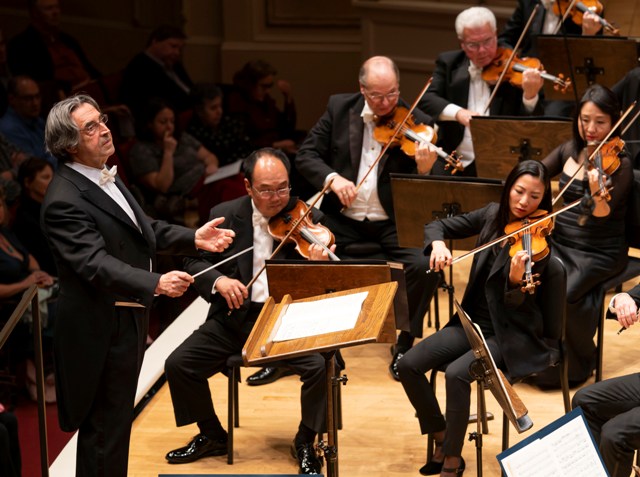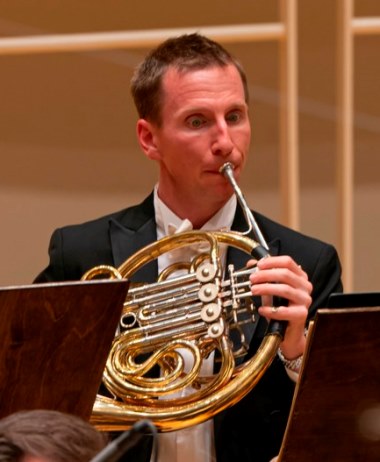Muti and CSO begin Beethoven cycle with leap from alpha to titanic ‘Eroica’ as the true omega

Chicago Symphony music director Riccardo Muti began his season-long cycle through Beethoven’s symphonies with a pairing of the First and Third. (Todd Rosenberg photos)
Review: Chicago Symphony Orchestra conducted by Riccado Muti, at Orchestra Hall through Sept. 28.
By Lawrence B. Johnson
When the Chicago Symphony Orchestra had sounded the last blazing notes of Beethoven’s “Eroica” Symphony to end the first concert in a season-long traversal of the nine symphonies with music director Riccardo Muti, I found myself wondering: Where do we go from here? Onward, of course. But upward? In this most universally embracing and aspiring of musical forms, did Beethoven ever actually transcend the “Eroica,” mind you, his third symphony?
What Muti and this virtuoso orchestra did with the monumental “Eroica” was exhilarating to witness. Though the 50-minute work is indeed monumental – its prodigious scope dwarfs any symphony written before – its monumentality is living, breathing, supple, human. The marvel of Muti’s approach to the work, and the orchestra’s splendid playing, resided in a combination of strength, grace, depth and fluency.
With his Third Symphony, Beethoven thought he was writing a heroic tribute to Napoleon, that seeming champion of democracy – until the wily general declared himself, in effect, dictator. The appalled composer rededicated his ambitious work “to the memory of a great man.” But the enduring heroism of the work remains palpable, and not because anyone any longer associates the “Eroica” with Napoleon, for good or ill. The work is a testament to the human spirit, to the human capacity for good and to the solemnity of mankind’s mortal struggle.
Muti made it instantly clear that his “Eroica” would be carved from granite; it would be vital, surging, crisply inflected. The work’s famous opening pair of chords, a double proclamation in E-flat major, set the pace and the dramatic pitch. What unfolded from there was a grand tapestry woven from fine threads of strings and winds, trumpets and horns, all driven and punctuated by incisive timpani. It was a glistening sound, exuberant and burnished and precise.
But the heart of the Third Symphony is its slow movement, a vast and fraught funerary paean – a Shakespearean soliloquy for orchestra. Here, too, Muti pushed the tempo, but just enough to avoid burdening true grandeur with artificial pomp. The great fugue at the movement’s center swelled with heated intensity, flashing and brilliant and otherworldly. Such is the collective instrument Muti has assembled in ten seasons as the CSO’s music director. The sound of the string choir, crystalline in the opening movement, now turned radiant, at once concentrated and buoyant.

Principals Stefán Ragnar Höskuldsson (flute) and William Welter (oboe) set the pace for heady woodwind exchanges with the strings through the “Eroica” finale.
The scherzo provides a bridge back from the empyrean to the here-below. It is specifically earthy, animated; and Muti indulged the music’s full measure of vitality, the horns percolating with particular zest. Likewise, the finale’s dazzling romp put the woodwinds on impressive display in heady counterpoint with strings and brasses – a fine summation to an “Eroica” long to be remembered.
Muti set up the Third Symphony with a vibrant performance of the First, the calling card with which the 30-year-old Beethoven announced himself to Vienna as rival to the venerated Haydn, the very father of the symphony and very much alive in 1800. The Symphony No. 1 in C is bold, even brash, in its harmonic sport, supremely confident in its technical gamesmanship and worthy of Haydn himself in its free-wheeling wit.
And that is just how Muti and company served it up: crackling, polished, not a little impetuous. It was, as Beethoven meant it to be, great sly fun.
By way of cueing up the whole symphony project, Muti opened the concert with Beethoven’s overture “Consecration of the House” from 1822, which puts it shortly before the Ninth Symphony. It was a clever choice. This remarkable overture deliberately, proudly approximates the style of Handel, whom Beethoven worshiped as the greatest of his musical forebears. Muti led an elegant, declarative performance touched by the stentorian punch of a Handel concerto grosso but also suffused with a fierce instrumental brilliance instantly recognizable as Beethoven.
Related Link:
- Performance and ticket info: Find details here


